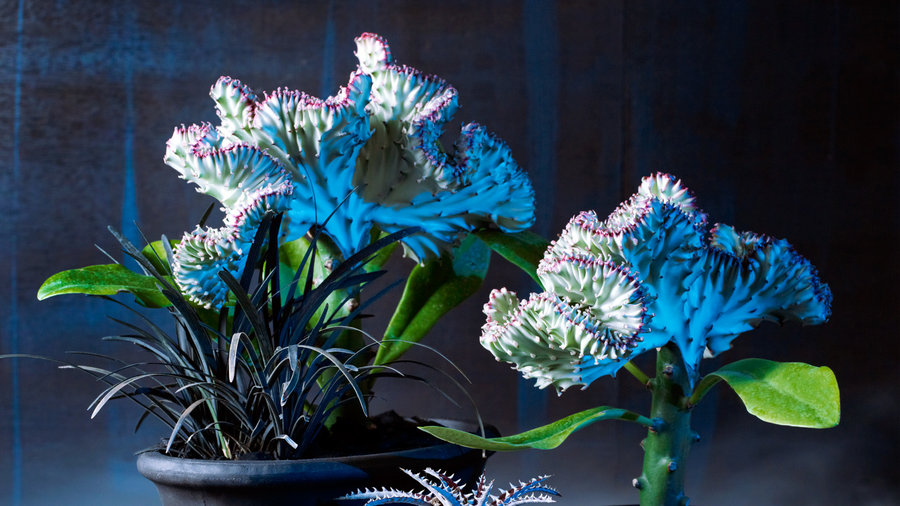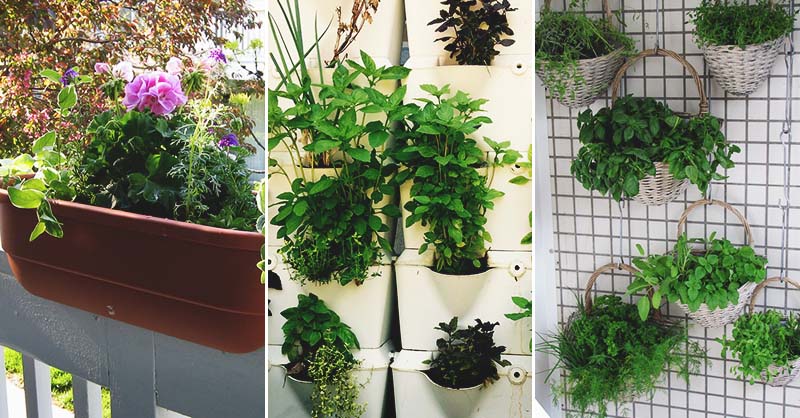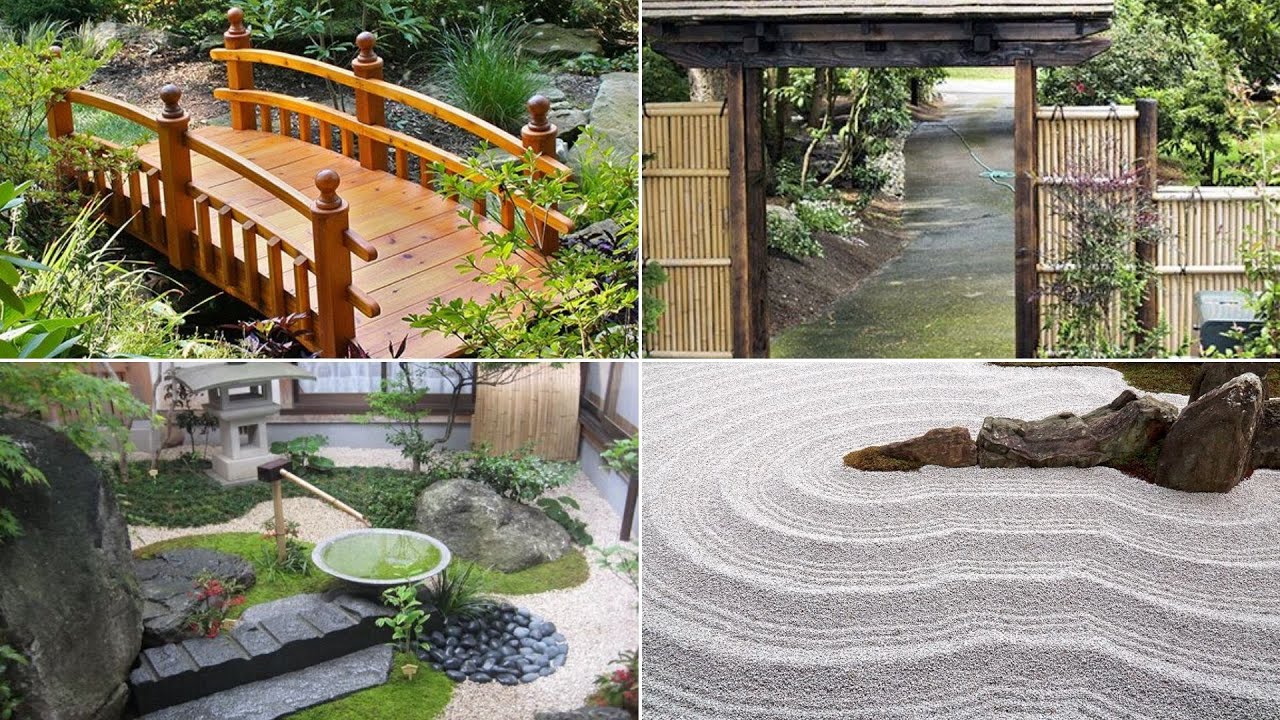Are you looking to add a pop of color and beauty to your outdoor space? Look no further! In this article, we will explore the wonderful world of beautiful hanging basket flowers. These vibrant and eye-catching blooms are not only a stunning addition to any garden but also a great way to elevate your outdoor decor. From cascading petunias to trailing fuchsias, we will discuss a variety of flowers that thrive in hanging baskets, providing you with tips and inspiration to create your own floral masterpiece. Get ready to transform your outdoor space into a blooming paradise with these gorgeous hanging basket flowers! Hanging basket flowers are a delightful addition to any garden or outdoor space. Not only do they add a pop of color and visual interest, but they also create a beautiful cascading effect that is sure to catch the eye. If you’re considering adding hanging baskets to your garden, there are a few important factors to consider to ensure you choose the right plants and properly care for them.
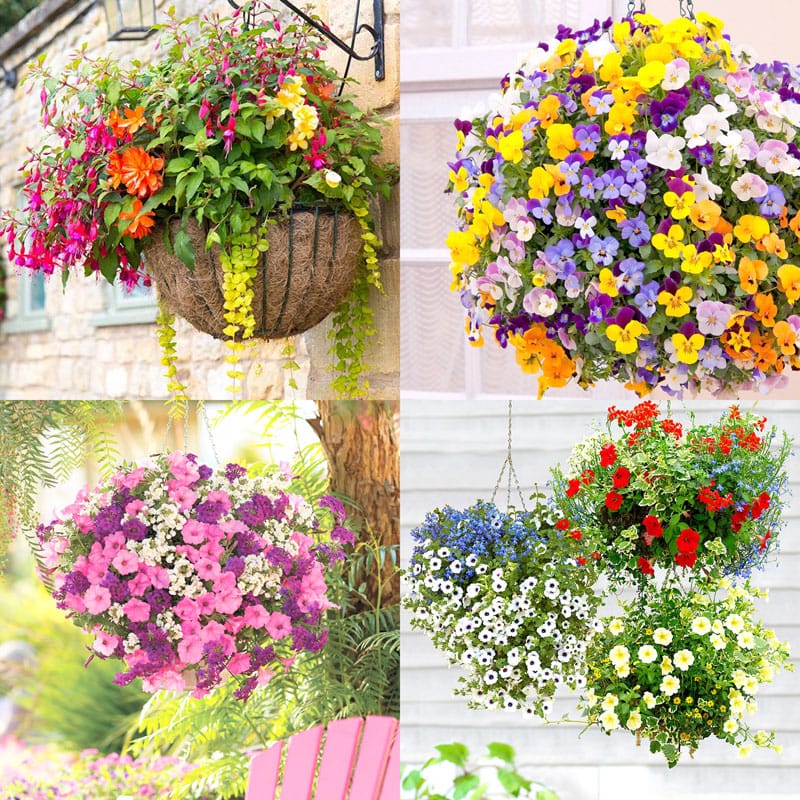
This image is property of www.apieceofrainbow.com.
Choosing the Right Plants
Consider Temperature and Sunlight Requirements
When choosing plants for your hanging baskets, it’s important to consider their temperature and sunlight requirements. Some plants thrive in full sunlight, while others prefer partial shade or even full shade. Take note of the specific needs of the plants you are interested in and choose ones that will be well-suited to the environment where your hanging baskets will be displayed. This will help ensure their health and longevity.
Evaluate the Size and Growth Habit
Another important factor to consider when selecting hanging basket flowers is the size and growth habit of the plants. Some plants have a more compact and mounding growth habit, while others have a trailing or cascading growth habit. Consider the space where your hanging baskets will be displayed and choose plants that will both fit and complement that space. Additionally, be mindful of the potential height of the plants to ensure they won’t become overcrowded or overwhelmed in the hanging basket.
Select Flowers with Long Bloom Periods
One of the key benefits of hanging basket flowers is their ability to provide continuous color throughout the season. To ensure long-lasting beauty, it’s important to select flowers with long bloom periods. Look for varieties that are known for their extended periods of flowering, such as petunias, fuchsias, geraniums, and begonias. These plants will bring vibrant color to your hanging baskets for weeks or even months on end.
Prepping Your Hanging Baskets
Choose an Appropriate Container
Choosing the right container for your hanging baskets is essential for their overall health and success. Opt for containers that are specifically designed for hanging purposes, such as wire or plastic baskets with built-in hooks or chains. These containers are not only convenient for hanging, but they also provide adequate drainage and airflow, both of which are crucial for the health of the plants.
Ensure Proper Drainage
Proper drainage is essential for the health of your hanging basket flowers. Without adequate drainage, excess water can accumulate in the soil, leading to root rot and other issues. To ensure proper drainage, make sure your hanging baskets have drainage holes at the bottom. You can also add a layer of gravel or small stones to the bottom of the basket before adding potting mix to facilitate drainage.
Use High-Quality Potting Mix
Using a high-quality potting mix is crucial for the overall health and success of your hanging basket flowers. Look for a well-draining mix that is specifically formulated for containers and hanging baskets. Avoid using garden soil or heavy clay-based soils, as these can retain too much moisture and lead to root rot. A good potting mix will provide the necessary nutrients and drainage for the plants to thrive.
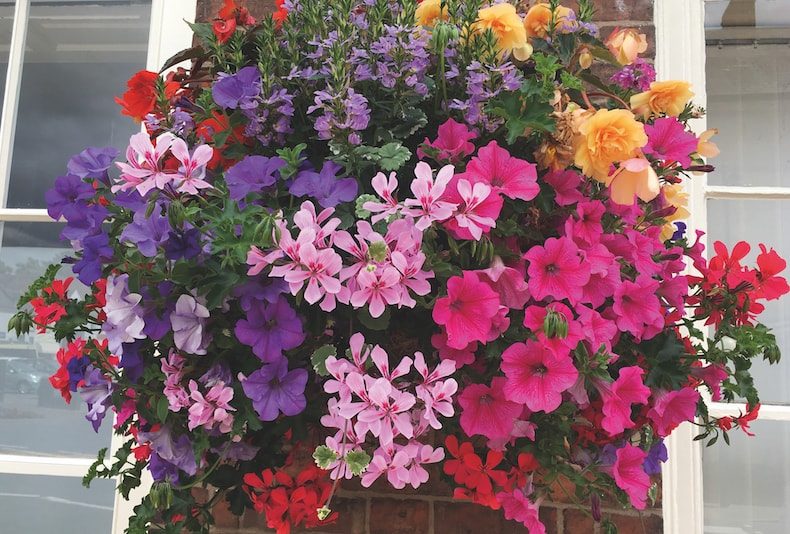
This image is property of www.thompson-morgan.com.
Popular Hanging Basket Flower Varieties
Petunias
Petunias are beloved for their vibrant colors and versatility. They come in a wide range of hues, from soft pastels to bold and bright shades. Petunias are known for their long bloom periods, making them an excellent choice for hanging baskets. Choose from trailing or mounding varieties depending on the desired growth habit.
Fuchsias
Fuchsias are delicate and elegant flowers that add a touch of grace to any hanging basket. Their pendulous blooms are often bi-colored, with vibrant hues of purple, pink, and white. Fuchsias prefer partial shade and can provide a stunning contrast to other flowers in your hanging baskets.
Geraniums
Geraniums are classic hanging basket flowers that never go out of style. They are available in a variety of colors, including red, pink, purple, and white. Geraniums are relatively low-maintenance and can tolerate a range of light conditions. Their vibrant blooms will bring joy and beauty to your outdoor space.
Begonias
Begonias are known for their showy flowers and stunning foliage. With their wide range of colors and textures, begonias can add a touch of elegance to any hanging basket. They prefer partial shade and can tolerate higher humidity levels, making them a great choice for shady areas or coastal gardens.
Caring for Hanging Basket Flowers
Watering
Proper watering is essential for the health and vigor of your hanging basket flowers. It’s important to keep the soil evenly moist, but not overly saturated. The exact watering frequency will depend on various factors such as the specific plants, the size of the hanging basket, and the weather conditions. As a general rule, check the moisture level of the soil regularly by inserting your finger about an inch deep. If it feels dry, it’s time to water. Avoid letting the soil dry out completely or waterlogging the roots.
Fertilizing
To ensure that your hanging basket flowers receive the necessary nutrients for optimal growth and flowering, regular fertilization is important. Choose a balanced, water-soluble fertilizer or a slow-release granular fertilizer specifically formulated for flowering plants. Follow the recommended dosage instructions on the fertilizer packaging and apply it according to the specified frequency. Be cautious not to over-fertilize, as this can lead to excessive foliage growth with minimal flowering.
Deadheading and Pruning
Deadheading, the process of removing spent flowers, is essential for encouraging prolonged blooming in your hanging basket flowers. Regularly inspect the plants and remove any faded or wilting flowers. This will divert energy towards producing new blooms rather than wasting it on seed production. Additionally, occasional pruning may be necessary to control the growth and shape of the plants. Trim back any leggy or overgrown stems to maintain a compact and bushy appearance.
Protecting from Pests and Diseases
Like any garden plants, hanging basket flowers are susceptible to pests and diseases. Regularly inspect your plants for signs of common pests such as aphids, mealybugs, or spider mites. If detected, take prompt action by using organic insecticidal soap or neem oil to control the infestation. Additionally, be vigilant for signs of common diseases such as powdery mildew or botrytis. Proper air circulation, regular watering, and maintaining overall plant health will help prevent the occurrence of many diseases.
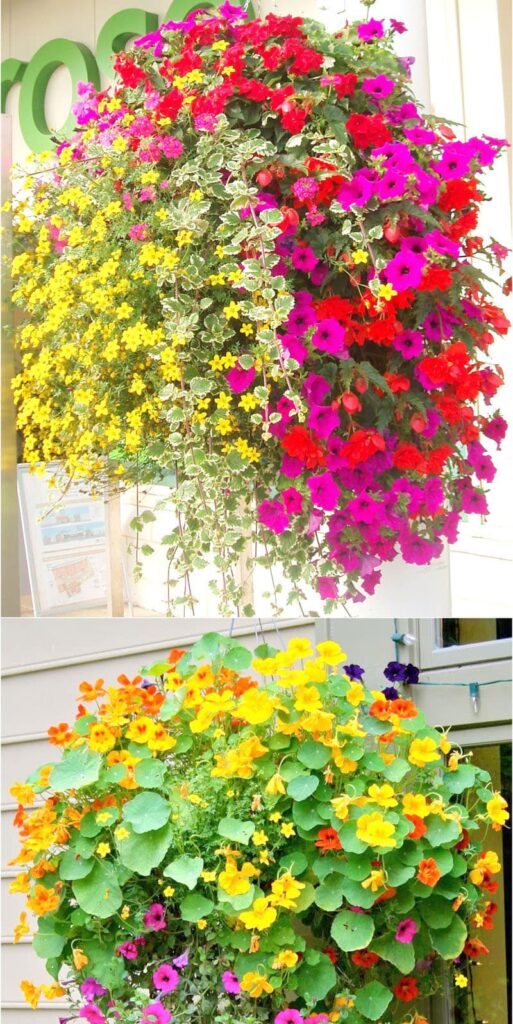
This image is property of www.apieceofrainbow.com.
Dealing with Common Challenges
Preventing Leggy Growth
Leggy growth is a common challenge faced by hanging basket flowers, especially those grown in low light conditions or without proper pruning. To prevent leggy growth, make sure your hanging baskets receive sufficient sunlight. Regularly pinch back or prune the plants to promote branching and compact growth. This will help create a fuller, more balanced appearance.
Addressing Overwatering or Underwatering
Finding the right balance of watering can be a challenge, and both overwatering and underwatering can negatively impact your hanging basket flowers. Overwatering can lead to root rot, while underwatering can result in wilting and stunted growth. Regularly monitor the moisture level of the soil and adjust your watering schedule accordingly. Remember that factors such as temperature, humidity, and plant size can influence the water requirements of your hanging baskets.
Managing Heat Stress
During hot summer months, hanging basket flowers are susceptible to heat stress, which can cause wilting, leaf burn, and overall decline in plant health. To manage heat stress, consider placing your hanging baskets in partially shaded areas or providing them with temporary shade during the hottest part of the day. Regularly monitor the soil moisture and avoid allowing the plants to dry out completely. Additionally, misting the foliage with water can help increase humidity and provide some relief.
Controlling Pest Infestations
Pests can be a persistent problem for hanging basket flowers, but there are several measures you can take to control them. Regularly inspect your plants for signs of pests, such as holes in leaves or sticky residue. Introduce beneficial insects, such as ladybugs or lacewings, to help naturally control pest populations. If necessary, use organic insecticidal soap or neem oil to target specific pests. Avoid using chemical pesticides, as they can harm beneficial insects and disrupt the natural balance of the ecosystem.
Creative Ideas for Hanging Baskets
Mixing Different Flower Colors and Textures
One of the most enjoyable aspects of creating hanging basket displays is the ability to mix different flower colors and textures. Consider combining flowers of varying heights, such as trailing lobelia or verbena, with more compact flowers like pelargoniums or petunias. Opt for a color scheme that complements your outdoor space and experiment with different combinations to create a truly dazzling display.
Using Vines and Trailing Plants
To add an extra dimension to your hanging baskets, incorporate vines and trailing plants. Plants such as sweet potato vine, ivy, or trailing nasturtiums can create a striking cascading effect, adding depth and visual interest to your display. These plants can also help fill out the hanging basket, creating a lush and full appearance.
Incorporating Edible Plants
For a unique twist, consider incorporating edible plants into your hanging baskets. Herbs like basil, mint, or thyme not only add a delightful aroma but are also useful in the kitchen. Some edible flowers, such as pansies or nasturtiums, can also be added to salads or used as garnishes. This combination of beauty and functionality is sure to impress your guests and enhance your culinary endeavors.
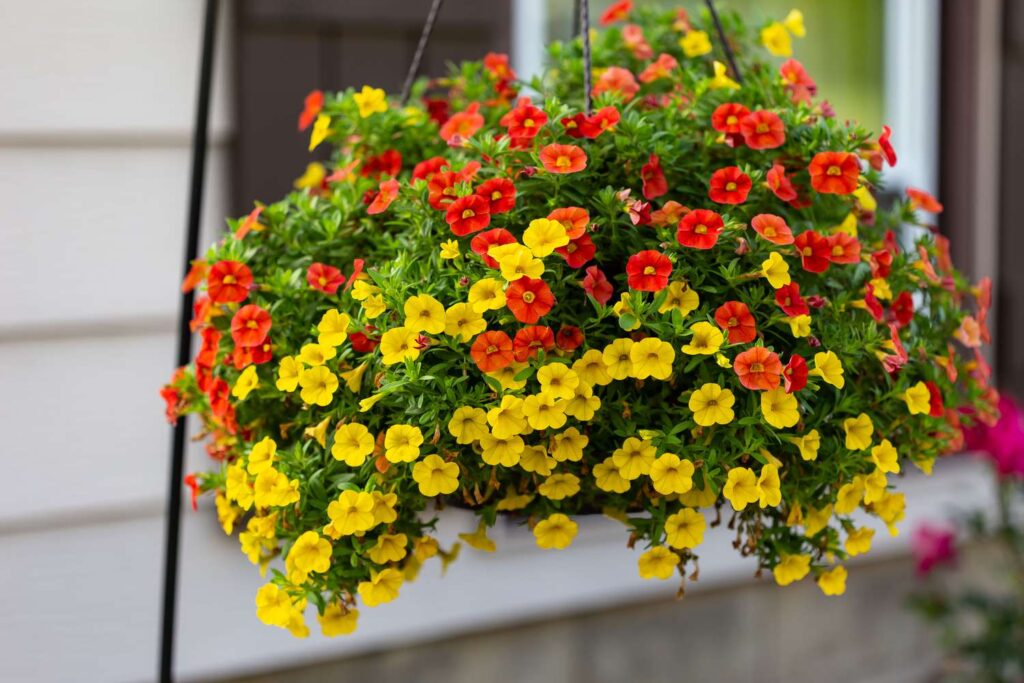
This image is property of www.thespruce.com.
Hanging Basket Flowers for Different Environments
Best Flowers for Shaded Areas
In areas with limited sunlight, there are still plenty of options for beautiful hanging basket flowers. Consider plants like impatiens, begonias, or fuchsias, which thrive in partial shade or filtered sunlight. These flowers will bring color and vibrancy to even the shadiest corners of your garden.
Ideal Flowers for Sunny Locations
If your hanging baskets will receive ample sunlight, you have a wide range of options to choose from. Sun-loving flowers such as geraniums, petunias, or marigolds are excellent choices. They will thrive in full sunlight and reward you with abundant blooms all season long.
Flowers for Coastal Gardens
Coastal gardens can present unique challenges, including salt spray and high winds. However, there are several hanging basket flowers that are well-suited to these environments. Consider plants such as lantana, geraniums, or heliotrope, which are known for their tolerance to salt spray and ability to withstand wind and harsh conditions.
Flowers that Attract Hummingbirds or Butterflies
For those who enjoy the presence of hummingbirds or butterflies in their gardens, there are specific hanging basket flowers that can help attract these delightful creatures. Plants like fuchsia, salvia, or verbena are known for their ability to attract hummingbirds, while butterfly bush, zinnias, or cosmos can entice butterflies to visit your hanging baskets.
Tips for Successful Hanging Baskets
Regularly Monitor and Adjust Watering
Hanging baskets require regular monitoring to ensure the plants receive adequate water. As mentioned earlier, check the moisture level of the soil regularly and adjust your watering schedule accordingly. Remember that hanging baskets can dry out more quickly compared to traditional garden beds or containers, so be attentive to the needs of your plants.
Feed the Plants Adequately
To support the vigorous growth and continuous flowering of your hanging basket flowers, it’s important to provide them with proper nutrition. Follow the fertilizer recommendations for each plant and feed them regularly throughout the growing season. A well-fed plant is more likely to resist diseases, withstand environmental stress, and produce abundant blooms.
Keep an Eye on Pests and Diseases
Regular monitoring for pests and diseases is essential for the health and vitality of your hanging basket flowers. Inspect the plants regularly and take prompt action at the first sign of infestation or disease. By addressing issues early on, you can prevent the spread of pests or diseases and minimize damage to your plants.
Rotate Hanging Baskets for Balanced Growth
To promote balanced growth and prevent one side of the hanging basket from becoming lopsided or uneven, consider rotating the baskets periodically. This will ensure that all sides of the basket receive equal sunlight exposure, resulting in more uniform growth and an aesthetically pleasing display.
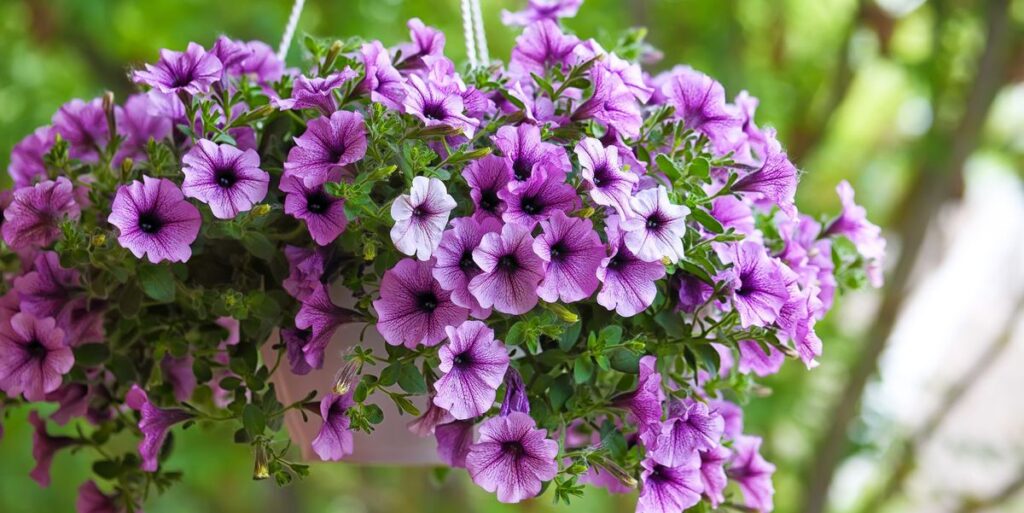
This image is property of hips.hearstapps.com.
Seasonal Maintenance
Pruning and Trimming During Winter
During the winter months, many hanging basket flowers go into a dormant phase or experience reduced growth. It’s important to prune and trim your plants during this time to remove any dead or diseased foliage and encourage healthy new growth in the following season. Cut back any leggy stems and shape the plants as desired, but be cautious not to prune excessively, as this can weaken the plants.
Storing Hanging Baskets in Cold Climates
In cold climates, it may be necessary to store hanging baskets indoors during the winter to protect them from freezing temperatures. Before storing, remove any dead or diseased foliage and give the plants a light pruning. Place the baskets in a cool, dark location with moderate humidity, such as a basement or garage. Avoid exposing them to freezing temperatures, as this can damage the roots and potentially kill the plants.
Reviving Neglected Hanging Baskets
Assessing the Plant’s Health
If you have neglected your hanging basket flowers and they appear to be struggling, it’s important to assess their overall health before taking any action. Look for signs of root rot, wilting, or pest infestation. If there are only a few affected areas, it may be possible to revive the plants with proper care and attention.
Pruning and Repotting
To revive neglected hanging basket flowers, start by pruning back any leggy or overgrown stems. Remove any dead or diseased foliage and trim back excessively long roots. If the plants are severely root-bound, it may be necessary to repot them into a larger hanging basket or container with fresh potting mix. Be gentle when handling the plants to avoid further stress or damage.
Gradually Introduce Water and Nutrients
After pruning and repotting, gradually reintroduce water and nutrients to the plants. Start with a light watering and monitor the soil moisture closely. Once the plants show signs of recovery, resume regular watering and fertilization according to their specific needs. Be patient, as it may take time for the plants to fully recover and regain their vitality.
In conclusion, choosing the right plants, prepping your hanging baskets, and providing proper care are essential for the success of your hanging basket flowers. By considering factors such as temperature and sunlight requirements, evaluating size and growth habits, and selecting flowers with long bloom periods, you can create a stunning display that will bring beauty and joy to your outdoor space. With regular maintenance, attention to watering and fertilizing, and proactive pest control, your hanging baskets will thrive and provide endless enjoyment throughout the season. Don’t be afraid to get creative with different flower colors and textures, incorporate vines and trailing plants, or even include edible varieties. Remember to tailor your selection of hanging basket flowers to the specific environmental conditions, whether it’s a shaded area, a sunny location, a coastal garden, or an area to attract hummingbirds or butterflies. With these tips and ideas, you’ll be well-equipped to create and maintain gorgeous hanging baskets that will be the envy of all who see them.


